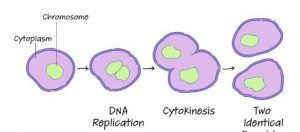Unit #1 Cells
Cell theory: 1. Every living thing is made up of one or more cells and their products
Cells are the simplest unit that carry out all life processes.
All cells come from pre-existing cells. They do not come from non-living matter.
Simplest Organisms: Archaea and Bacteria (prokaryotes)
Prokaryotes:
No nucleus
No membrane bound organelles
(capsule, plasmid, flagellum, pilus)
Eukaryotes :
Complex cells
Can exist as single celled organisms or multicellular organisms
have complex internal organization/components
10 - 1000 x bigger than prokaryotes
Have nucleus
protists, fungi, animals, plants
Cell Structure:
Cell wall:
multilayered (3)
support and protect the cell
controls the direction of cell growth
selective transportation
Plants only
Cell membrane:
Fluid-mosaic membrane
separates the cell interior from outside
controls movement in and out of cell
Both plants and animals
Cytoplasm:
consists of mostly water and dissolved materials
creates chemical environment where the other cells work
Both
Vacuoles:
fluid filled sac
temp. storage of food water, or waste products
Both (big in plants, small in animals)
Nucleus
contains DNA
double membrane
control center of cell
contains DNA blueprints for making proteins
Both
Chromosomes:
located inside nucleus (microscopic)
carries hereditary info. (genes)
helps organize genetic material during cell division
Both
Endoplasmic Reticulum:
flattened membrane-bound sacs and tubes
Rough ER is studded with ribosomes
Rough ER: synthesizes protein
Smooth ER: synthesizes phospholipids and packages macro molecules in vesicles to transport to other parts of cell
Both
Golgi Apparatus:
stack of flattened membrane bound sacs that contain enzymes
receive vesicles from ER
contains enzymes for modifiying protein and lipids
sends finished product to vesicles to go to cell membrane
Both
Mitochondria:
double membrane system & has own DNA
powerhouse of cell
generates energy (atp)
signals between cells & cell death
heat production
stores calcium
Both
Chloroplast:
type of plastid & has double membrane
photosynthesis
Plants only
Ribosomes:
half protein half RNA
produce proteins from amino acid (protein synthesis)
Both
Lysosomes:
contains digestive enzymes
breaks down cellular wastes and debris
can kill other cells
helps maintain homeostasis
Animals only
Chromatin:
mix of DNA, RNA, and proteins that form chromosomes
condense and package DNA
Both
Nucleolus:
found in cells nucleus (sphere)
produce and assemble ribosomes
RNA
Both
Transport in Cells:
Homeostasis - the state of steady internal, physical, and chemical conditions maintained by living systems
Passive Transport: 1. Diffusion -movements of a molecule from a region where they are more concentrated to one where they are less
2. Osmosis - the diffusion of water molecules across a semi-permeable membrane down a concentration gradient
Facilitated Diffusion -diffusion through a carrier/channel protein molecule
Carrier Protein: will accept only a non-charged molecule with a specific shape
Channel Protein: allows charged particles (must be small and have the right charge)
Active Transport: 1. Active transport pump - the process of moving substances against a concentration gradient
Bulk Transport -mode of transport of large quantities of materials and food particles across the membrane. Occurs inward and outward.
Phagocytosis: ingest or engulf other cells or particles
Endocytosis: Ingestion of large particles (bacteria) and the uptake of fluids or macromolecules in small vesicles
Exocytosis/ectocytosis: Fusion of secretory vesicles with the plasma membrane and results in the discharge of vesicle content into the extracellular space
Pinocytosis: Active, energy consuming process where extracellular fluid and solutes are taken up into a cell via small vesicles
Isotonic: equal concentration of solutes inside and outside the cell. Cell is the same.
Hypotonic: Less solute in the solution than in the cell. Cell is Lysed (bigger).
Hypertonic: Higher concentration of solute (ex. cell expands and dies due to lysis)
Cell cycle:
interphase (every phase except m phase): -resting phase - cell grows and prepares for cell division by duplication of genetic material
cytokynesis: cycle begins
G1 phase: cell grows
S phase: cells recieves instructions regarding divisions, Dna replicates
G2 phase: cell prepares to divide
M phase (mitosis)
Bacteria:
contains ribosomes, cytoplasm, chromatin/chromosomes (nucleoid), Flagellum, capsule, plasma membrane, pilus
Naming Bacteria:
rod shaped bacteria is called bacillus (bacilli)
sphere shaped bacteria is called coccus (cocci)
spirochete shaped bacteria is called spirillium (spirillia)
bacteria in pairs are diplo
bacteria in chains are strepto
bacteria in clusters are called staphylo
Bacteria Reproduction:
binary fission
single circular chromosome consists only of double stranded DNA
Chromosome duplicates, the two chromosomes attach to the inside of the cell membrane
cell produces division furrow which is the beginning of a septum. (eventually will turn into a cell wall.
cell membrane grows inward and the cell wall completely forms.
original cell splits into two smaller genetically identical cells.

Conjugation:
genetic recombination
recipient cell connects to donor cell using a conjugation tube (pilus)
makes a copy of some of the donor cells DNA (plasmid)
Plasmid makes its way to recipient cell through pilus
Viruses:
do not contain cells or any cellular structure
not considered organisms
non-living
composed of a protective coat of protein called a capsid and DNA or RNA
DNA or RNA is used to rewrite the host cells genome and produce more viruses
Lytic cycle:
Attachment: -virus lands on host cell
Entry: -RNA or DNA enters the host cell and become part of the host cell’s genome
Replication: -hijacked host cell creates new viral parts
Assembly: -viral parts are assembled
Lysis: -manufactured viruses bursts out of host cell, causing the host cell to die
 Knowt
Knowt